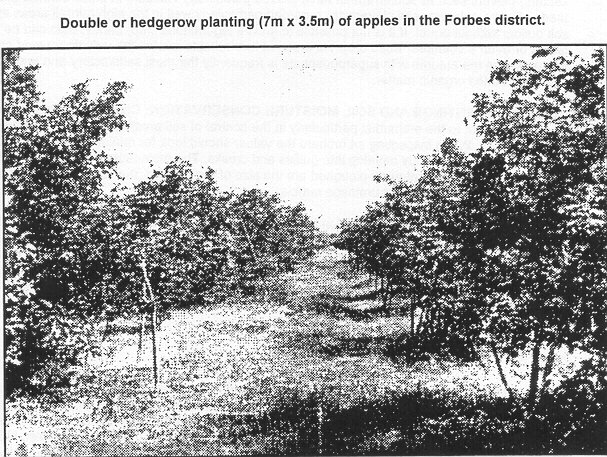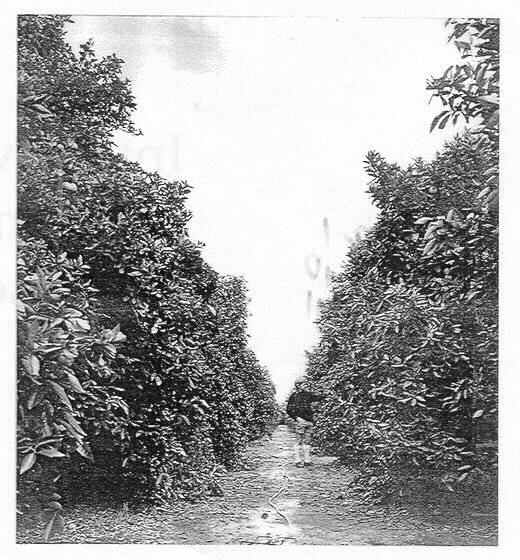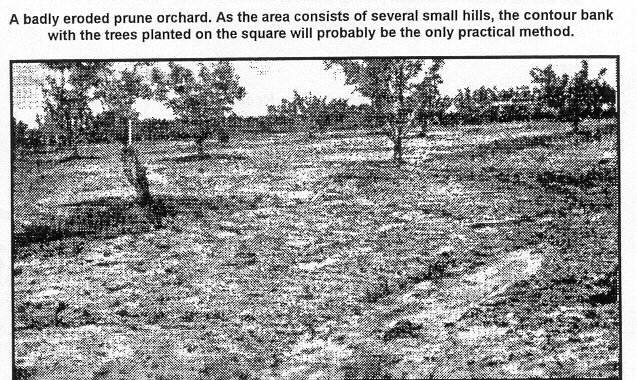ORCHARDS
david hornby
There
are a number of commercial fruitgrowing districts in Australia each
with certain advantages and disadvantages for certain fruits. Many
districts can be subdivided into sub districts using soils, altitude
and fruit maturing dates. The following factors affect the siting of
an orchard:
- type of fruit
and suitability of district
- seasonal
advantages of the district in regard to maturity dates
- proximity to
market and availability of transport
- the
availability of irrigation particularly, if the area is marginal
- freedom from
late frosts
- suitability of
soil particularly, in regard to drainage
- industry
facilities such as cool stores and canneries
- state of
plantings for example, a particular fruit or variety may be greatly
over planted in the district.
SOIL
AND SUBSOIL
A
deep friable loam is suitable for most fruit but some prefer lighter
soils. In some districts apples and pears do well on heavier soil in
which peaches could not be expected to do as well. Apricots prefer
heavier soils than peaches. However, deep loams are not always
available and newer orchards are often established on inferior soils.
The lack of fertility can be easily overcome by the application of
fertilizers, the most popular being poultry manure. The class of the
subsoil is important because it does not matter how good a shallow
soil may be, it will be no good for fruit trees if the subsoil is
heavy and almost impervious to water. Such a soil becomes quickly
waterlogged during a wet period and will dry out just as quickly
during a dry period.
Another
reason for the importance of the subsoil is because of the increasing
use of seedling stock, it is most important that a good medium be
provided for their deep roots.
Successful
orchards can be established on poor sandy soils for example, when the
sand overlays a deep subsoil of friable clay where water can
percolate freely and the roots of the tree can penetrate. This is
shown by a number of successful orchards located on sandstone country
near Sydney. However, very deep sands are not suitable as the
moisture and nutrients rapidly percolate down beyond the reach of the
roots. For pome orchards the soil must be fertile and well drained.
Shallow soils overlying heavy clay, ironstone or gravel or very sandy
subsoils are unsuitable for commercial apple growing.
The
successful apple areas in Australia are either on granite (Stanthorpe
region of Queensland) or rich basalt soils with a deep friable and
clayey subsoil (Arding/Kentucky region in NSW). Provided that the
granite soils are of good depth and the subsoil conditions are
favourable, produce excellent quality apples, particularly of the
long keeping cool storage varieties.
SLOPE
In
is common practice to site an orchard on the slope of a hill to
escape the detrimental effect of frosts. A slight slope has the
advantage of being easier to drain away surplus moisture but
excessive slopes can cause problems with operating equipment safety
and soil erosion. Rocky soils may be favoured as being better
drained.
SUPPLEMENTARY
IRRIGATION
Supplementary
irrigation is most important for all the major fruit growing ares.
Because a district has high rainfall does not mean that irrigation is
not necessary because the rain pattern may show a high variability.
The availability of irrigation during dry periods greatly reduces
risks of production. The possible sources of water include creeks,
dams, bores and springs. An irrigation licence from the appropriate
water authority is necessary.
ACCESSIBILITY
TO MARKET
Proximity
to market is most important especially for stone fruits where delays
in marketing can cause heavy losses. High transport costs can make an
orchard uneconomical and therefore most successful orcharding
districts have good rail/road communications and access to one or
more of the major markets.
SOIL
PREPARATION
It
is essential for the orchardist to eradicate weeds and couch grass. The
soil should then be worked a number of times with a cultivator
using curved tynes which works the remaining couch to the surface.
This operation should be carried out while the land is dry.
PLANTING
DISTANCES
There
is a trend towards closer planting. Climate, particularly rainfall
and soil fertility are major factors but the trend towards dwarfing
rootstocks and changes in orchard practices determine this. The
smaller trees mature quickly, are easier to maintain and pick, and
the smaller uniform size fruit is most suitable for the export
market.
Trees
in good rainfall areas require a reasonable distance between them to
enable proper growth and expansion of roots. They are often planted
close together but the rows are spaced further apart. This applies
particularly to contour ploughed paddocks when cross cultivation is
impossible and the additional space between the rows allows the most
efficient use of power equipment. The closer plantings of rows
results in about the same number of trees per hectare.
The
hedgerow planting system is particularly favoured for the
"drive past" methods of spraying and when incorporated with
appropriate rootstocks, varieties, irrigation and other management
techniques a large reduction in production cost can result.
COVER
CROPS
Most
of the stone and pome fruit is grown on the coast, tablelands and
slopes of NSW were the soils are subject to erosion. Whereas clean
cultivation was once advocated more use is now made of cover crops
and volunteer grass cover. Most orchardists maintain a cover growth
during the winter months and this is usually roughly worked or mown
in July or August to suppress further growth. The ground is left in
a comparatively rough state until further cultivation becomes
necessary.
The
use of subclover in orchards has assisted in soil erosion control by
improving soil fertility and preventing runoff. Organic matter plays
an important part in the maintenance of soil fertility. In its
virgin state, most first class apple growing land consists of a good
crumbly structure plentifully supplied with organic matter.
Under
any system of continued cultivation it is difficult to check losses
of humus from the soil and every effort should be made to maintain
and if possible increase the humus content of the soil. This can be
achieved economically in most cases by growing and turning in green
manure crops, preferably of the leguminous type such as clovers,
peas, beans, vetches etc. Of these the self seeding clovers such as
subterranean have proved particularly valuable in those districts
suited to them.
Today,
subterranean clovers are regarded particularly well in the high
rainfall areas as a soil builder without equal. If it is not possible
to grow a leguminous crop; barley, oats can be grown or even a
volunteer weed crop. In areas of less reliable rainfall the
volunteer weed crop, topdressed in the autumn with superphosphate is
frequently the most satisfactory and economical source of added
organic matter.
CONTOUR
PLANTINGS AND SOIL MOISTURE CONSERVATION
Contour
plantings provide particular benefit to the orchardist particularly
in the control of soil erosion and the provision of water supplies.
When inspecting an orchard the valuer should look for miniature
washes which if left unattended, will quickly develop into gullies
and creeks. The main factors in deciding whether or not an area can
be contoured ploughed are the size of the orchard, number and
location of depressions, and provision for drainage outlets.
Contour
planning of orchards in addition to controlling soil erosion has
other advantages such as allowing more water to percolate through the
soil and into the subsoil.
The
steeper the slope, the quicker the runoff and by reducing the slope
through contour ploughing the water moves more slowly and a far
greater amount is admitted to the soil and subsoil. This factor is
particularly important in low rainfall areas. The block becomes
slightly terraced which is an advantage from a soil erosion,
maintenance and water conservation point of view.
see
apple growing
DOUBLE
OR HEDGEROW PLANTING (7x3.5) OF APPLES IN THE FORBES DISTRICT
OLD
STYLE LARGE TREE ORCHARD
A
BADLY ERODED PRUNE ORCHARD, AS THE AREA CONSISTS OF SEVERAL SMALL
HILLS, THE ONTOUR BANK WITH THE TREES PLANTED ON THE SQUARE WILL
PROBABLY BE THE ONLY PRACTICAL METHOD
7



